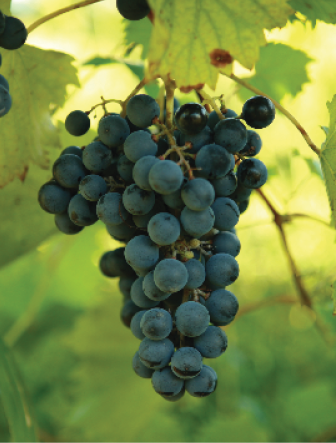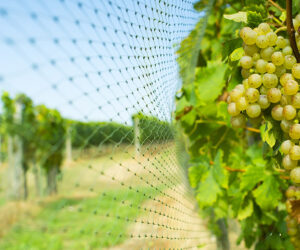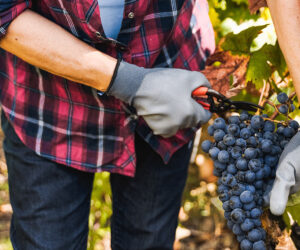 In trying for the “perfect” wine there are many factors to deal with. The culture of the vine can only be adjusted so much — soil, pruning, training and microclimate all have their limits. The part you can most control is your choice of grape variety. There are enough varieties in the world that most winemakers find at least one that works well enough to suit them, but for others no grape is “just right.”
In trying for the “perfect” wine there are many factors to deal with. The culture of the vine can only be adjusted so much — soil, pruning, training and microclimate all have their limits. The part you can most control is your choice of grape variety. There are enough varieties in the world that most winemakers find at least one that works well enough to suit them, but for others no grape is “just right.”
The solution? Breed your own grapes. Grape breeding doesn’t take a college degree or special equipment, and while there is no absolute guarantee you will create a wine grape perfect for your climate, odds are good the result will be worthwhile. Add the fact that it will be your own creation, and breeding can be immensely satisfying.
Grape Biology Basics
First, it helps to know a little bit about grape biology. Grapes bloom differently than other flowers. Grape petals are green, and instead of blooming they detach at the bottom, coming off the flower as a cap. Because of their appearance, the unopened buds are often mistaken for small green grapes. All wild grape species are dioecious — each vine has either male or female flowers. The male flowers have fully developed anthers (the pollen-bearing organs), but little or no ovary or pistil. Female flowers have a large, well-developed ovary and pistil, and while the anthers are nearly as large as those of the males, they are reflexed under the flower (they curve down and under) and any pollen they produce is sterile. Pollination is by wind and insects, such as small flies.
Most cultivated grapes have “perfect flowers,” with a normal ovary and pistil and fully developed, upright anthers. (In other words, they are both male and female.) This means that cultivated grapes are mostly able to set fruit by self-fertilization, with a few exceptions. Some older varieties have female flowers, but had such good qualities that they were not discarded when perfect-flowered types came along, and must be planted near perfect-flowered types to set a crop.
Each flower in a cluster of a perfect-flowered or a female-flowered variety can “set” and become a single grape. However, in most varieties only 20 percent of the flowers set, at most. Any more than that and the grapes are packed so tightly on the mature cluster that they crush and split each other. In well-filled clusters, 10 to 15 percent of the flowers become berries. It’s worth nothing that here are varieties that appear to be perfect-flowered but have weak pollen. These varieties don’t set good crops unless a second variety is planted near them. There are also female-flowered types that can set full clusters of small seedless berries if they are not pollinated by another.
None of the common commercial varieties has these traits, but they do show up often enough to be worth noting. Just about all the grapes you are apt to buy in nurseries are perfect flowered and will self-fertilize — be both the “mother” and “father.” The most important aspect of breeding grapes is controlled pollination — making sure you know what the parents of your seedlings are.
The method used by commercial and university breeders is to emasculate the flowers, which involves removing the cap with fine tweezers in a way that pulls off the anthers without harming the ovary or pistil. It’s not especially hard to learn, but it can be tedious and time-consuming. Instead, here are simpler methods that, while not always as exact, will still give a beginner a good chance of success.
Growing seedlings
If you’ve found a grape that mostly suits you, it may be worthwhile to grow seedlings of it. Even though most commercial grapes are self-pollinating, grapes have a lot of variation in their genes. Plant a hundred seeds and none of the seedlings will be exactly like the original variety. This means that a seedling of that “almost perfect” grape could inherit a combination of genes that corrects the problem you have with it. For example, if a grape is late-ripening for you, odds are good that some of its seedlings will ripen earlier.
This method only works if a trait is present in the grape to start with. If you plant seed of a grape that is white, odds are good all the seedlings will have white fruit, unless pollen of a red grape somehow reached a flower. If a variety has no resistance to mildew, the seedlings are unlikely to have any either. However, if a grape has some resistance to mildew, it’s possible that a seedling could inherit a new combination of genes and wind up with greater resistance.
Also, for many traits it’s possible that there may be hidden “recessive” genes that will surprise you. For instance, Cabernet is a blue grape, but it can produce seedlings with white fruit because it has recessive genes for that fruit color.
Remember that more than a few traits are reshuffled in the seedlings — dozens are recombined in any one offspring. This means an improvement in one trait might be offset by a weakness in another. To beat the odds, it is usually necessary to grow a lot of seedlings to find one that has all the traits you want. There is no set number, but 100 seedlings is a good baseline. With that many, you may or may not find what you want, but you will almost surely find enough to help decide if it’s worth growing more seedlings. If nothing in the 100 comes even close, odds are that you won’t find what you want in a larger group. The easiest thing about this method is that seed can be collected from the bottom of the fermentation tank during winemaking — seed isn’t harmed by fermentation — so getting a quantity of seed to work with is simple. (I’ll explain how to grow seeds shortly.)
Let’s walk through what you can expect with this and other breeding methods. Pick any nice ripe cluster of grapes (or collect seed as above) and remove the seeds from the fruit. Let’s say we’re working with Marechal Foch. First, grow the seedlings out. Now let’s start eliminating some. Twenty-five of the 100 seedlings (for example) get powdery mildew, when Foch itself does not. Remove those. Of the remaining 75, 10 get more black rot than Foch. Out. Of the remaining 65, five are runts or slow-growing. Out. By the time you have taken out all the poor-growing, diseased types, you are probably down to 50 or less of the original 100. Train them up to have one good cane. End of first year.
With good care, many can start to bear the second year. It’s possible that 20 or more will have female flowers. You might keep those for further breeding, but they are out as varieties since they would have to be pollinated by a second variety to bear fruit. Down to 30. When the first crop ripens, you will probably eliminate some as ripening at the wrong time — too late (or less likely) too early. Eliminate 10-15. Some may be removed for problems like fruit rot. Now you are down to about 15 or less from your original 100. If there is at least 5 pounds of fruit, you can make a sample batch of wine. That will eliminate more of the seedlings for poor quality. If not enough fruit, try again the next year.
By the time all seedlings have borne fruit you have eliminated just about everything, and if all went well, you will have about one seedling of the original 100 that either has everything you want, or is close enough to it to show that you could grow a larger number of seedlings — say 300 — and probably find just what you wanted. You have spent anywhere from five to ten years to get to this stage, though you might find a good seedling within three years under ideal conditions. Even at that, it would be wise to make wine from your “find” for at least three years to be sure it will be consistent.
Crossing grape varieties
When a variety lacks a trait altogether, it’s necessary to cross it with another that has what you want and hope everything will recombine the right way in a seedling. Crossing two varieties takes a bit more work than just growing seeds from one grape, but there are easy “shortcut” methods. First, choose the parents. Pick varieties that either reinforce each other in desirable traits, or complement each other for strengths and weaknesses. Avoid crossing parents that reinforce each other negatively — both are susceptible to the same disease, for instance. If yours is a disease-ridden climate, having both parents resistant to disease helps ensure healthy offspring. One resistant and one susceptible parent are more likely to yield an intermediate offspring than a fully resistant one, though a trait can be fully dominant. As a case in point, crossing a very cold-hardy grape with a relatively tender grape can still give offspring with good cold hardiness. Legendary breeder Elmer Swenson, for example, crossed Minnesota #78 with S. 11803. While #78 is hardy to more than -40° F, S. 11803 is as tender as pure vinifera. Yet, the result, Swenson Red, is hardy to -30° F.
If you want an idea beforehand of what you will get, the inheritance of most of the important traits of grapes has been worked out and can be researched, but you’ll get results even if you don’t know exactly what to expect. A “quick and dirty” way to make crosses is to have the parents growing side-by-side, in the ground or in pots. They should bloom at the same time to try this.
Train canes from each vine so they can be intertwined. When the shoots bearing flower clusters come out, tie them together so the clusters are together. This will ensure that a large proportion of the flowers will get pollen from the other variety. If you want to be sure the two are crossing, look for a trait in one that can act as a marker — red tendrils, unusual leaf shape — that the other variety lacks. Then when you grow the seed of the other variety, any seedlings that have the trait can be assumed to have inherited it from the “marker” variety. You can grow the seed from both clusters, since either could have gotten pollen from the other.
A simple method used by many grape breeders is to use female flowered varieties as the female parent. Females are much easier to use in breeding and breeders often save good ones for that purpose. For instance, the aforementioned MN #78 has female flowers. With such vines, all you need do is bag the flower clusters with a bag before they bloom (see illustration). At the same time, put bags on clusters of the variety you want to use as the male parent, before the flowers bloom. Bag at least twice as many clusters of the variety to be used for pollen as the variety with female flowers. Peek in the bags daily in the morning, and when the female flower cluster is in bloom (at least 50 percent of the flowers are open), find a cluster in full bloom from the male variety. Snip the “male” cluster and drop it into the bag on the female cluster. Shake the bag gently. This will get pollen on most of the open female flowers and they will be fertilized and set seed. For insurance, give the bag a shake every morning for about three days to pollinate any late-blooming flowers on the female cluster. Don’t worry if a lot of the flowers don’t set — on most grapes only 10 to 20 percent will set, at best.
Growing grape seed
Seed is mature enough to grow when the berries turn color. Cut the berries in half and remove the seeds. Put them in water; any that float are hollow and won’t grow. Mix the fresh seed with a tablespoon of moist peat per 100 seeds, then place the mixture in a Ziploc bag and store it in the refrigerator. It should be cold, but not freezing. This is called “stratification” and it induces dormancy. Three months at 32 to 45° F is enough to stratify grape seed. The seed will stay dormant if you need to hold it longer, even until the next year.
Seed can be planted in two-inch square pots (one per pot) or in flats, in a greenhouse or cold frame. At temperatures of 75° F by day and 65° F at night, seed will start to emerge in two to four weeks. Once germination starts, seedlings will come up in as little as a week, though it can take as long as a month. Anywhere from 30 to 90 percent will germinate. Seeds that don’t germinate the first time can be put back in the refrigerator and more will grow after a second treatment. Some of the seedlings from these double-stratified seeds can be unusually strong and vigorous. The American species Vitis riparia and V. rupestris, and varieties that contain them (many of the French hybrids), give a faster germination rate and a larger percentage of seedlings the first time than labrusca, vinifera and similar species.
Set out the seedlings after they have at least six true leaves and all danger of frost has passed. They can be planted six inches apart in a nursery row the first year, then moved to a test row the next year while still dormant, or planted directly in a test row at two to three feet apart. (A test row is trellised similar to a regular one, but has only one wire.) Starting seedlings in a nursery allows you to eliminate obvious poor ones before putting them in the test row, but transplanting means more time before they come into bearing. Planting directly in a test row means you can bring the seedlings into bearing sooner, but takes more space and requires extra care.
Train seedlings to one good, short cane on the wire. At two- to three-foot spacing, you won’t have room for much more anyway. Don’t coddle the seedlings — if one is weak-growing or gets diseased, take it out. However, don’t judge everything the first year it bears. A vine that has a small crop the first year may improve.
Once the vine has at least five pounds of crop, you will need to make a wine sample from each seedling. Five pounds is enough to make a “tenth” (4/5 pint) for a wine test. A good rating system is 0 to 10, with 0 meaning wine that has a flaw due to a winemaking error and 10 equaling the best. A 5 is equal to a standard commercial wine. Test three years in a row to be certain. A 5 or better all three years and the seedling is worth propagating for large-scale tests.
The slowest part of wine-grape breeding is testing your new creation. Ten years of winemaking with a new grape is just barely enough to be sure it’s quality is consistent and it grows well in different conditions. You might not get rich on your new variety, but you’ll find it a fulfilling experience.







